Toshiba X305-Q725: Quad-Core Gaming Notebook
by Jarred Walton on March 11, 2009 1:00 AM EST- Posted in
- Laptops
General Application Performance
Wrapping things up with our performance testing, we have results from the Futuremark PCMark testing suites as well as some of our own application benchmarking. When it comes to running your office, multimedia, and Internet tasks, most modern laptops are more than fast enough. What follows are a few of the more strenuous application benchmarks - 3D rendering and video encoding - that put more of an emphasis on high CPU speeds. If you don't do that sort of thing on your computer, you will probably find that just about any Core 2 Duo processor is more than fast enough.
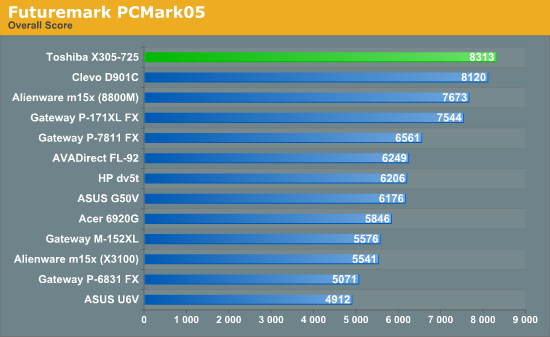
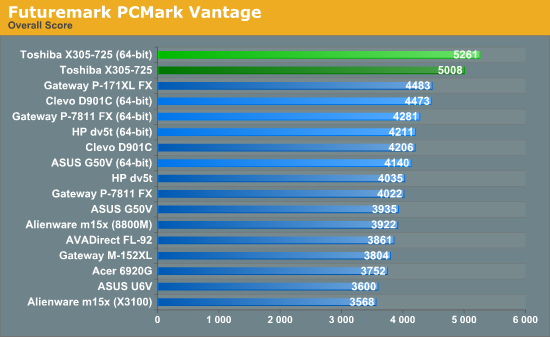
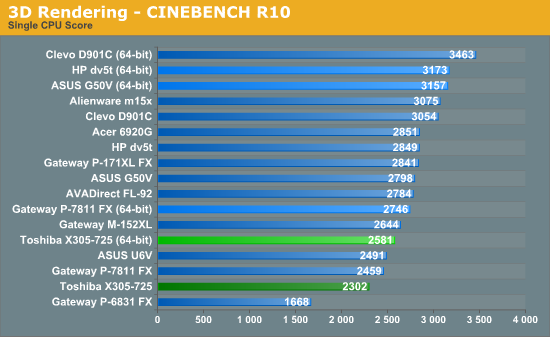

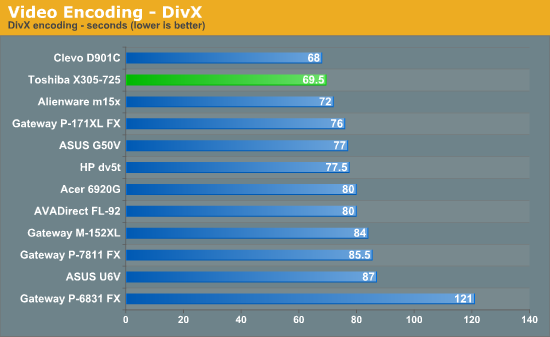
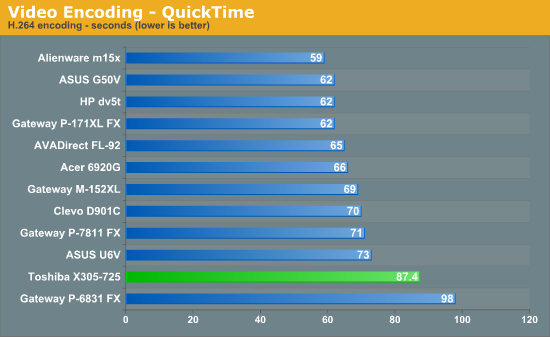
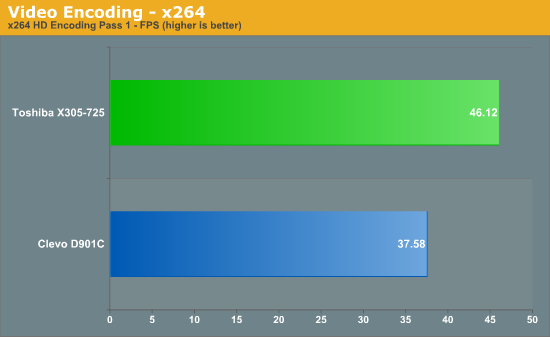
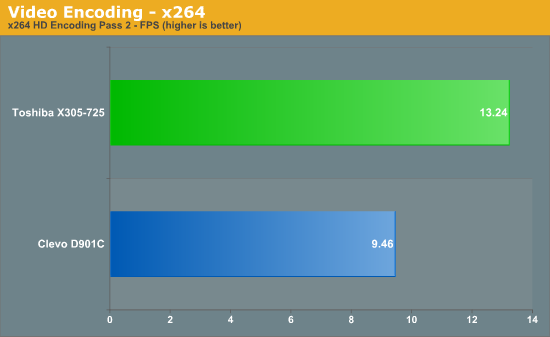
The quad-core CPU in the X305-Q725 does show its muscle in several of these tests, and the SSD helps elsewhere. PCMark definitely benefits the most from the SSD, with several of the tests stressing the ability to stream large amounts of data. Other tests like QuickTime were actually slower with the SSD, because of delays in writing the data. QuickTime also shows a situation that still occurs even with complex tasks on occasion: the lower clocked quad-core CPU ends up being slower than the dual-core CPUs because QuickTime won't utilize more than two CPU cores. DivX also fails to fully utilize the quad-core chip, with the total performance improvement over the E6850 at just 2.2%.
On the other hand, x264 benefits substantially, especially when you factor in clock speeds. Four cores at 2.0GHz theoretically provide up to 8GHz of processing potential, and the two cores of the E6850 at 3.0GHz provide 6GHz of potential, making the maximum theoretical improvement (all other things being equal) just 33%. The E6850 is an older architecture (Conroe instead of Penryn) but the E6850 also has more L2 cache per core; the fact that the Q9000 ends up being 40% faster on the second pass shows that there are scaling benefits from the newer architecture.
3D rendering is often able to scale almost perfectly up through four to six threads, so CINEBENCH R10 multi-core shows a nearly perfect increase of 32%. It's interesting that the single-threaded CINEBENCH score only shows a 33% advantage for the E6850, so again architectural changes in the Penryn core benefit the Q9000.
Overall, the X305-Q725 with the Q9000 looks like a good choice for highly threaded workloads, and the SSD can help in a few instances as well. However, there are competing laptops that offer similar performance for less money, or more performance for a similar cost, which makes the X305-Q725 more difficult to recommend.










32 Comments
View All Comments
Morelian - Wednesday, March 11, 2009 - link
I've had 2 of the Gateway FX series of notebooks, the first one was the 3mb Vista 32 version with a slower dual core, but it seemed to run games "ok"-WoW, TF2, AoC. Sadly the monitor got stepped on, so now this one is beside the TV functioning as the home media server and does a fine job of that. The first Gateway cost around 1300, then last one was 1050 but they are going for 1150 in Bestbuy now. The newer Gateway has the 2.6 mhz cpu, 4 gb ddr3 and a nicer screen and I find it handles whatever games I throw at it reasonably well. Battery life is about 2 hours, and the large keyboard lets you get work done efficiently.I think I'll wait until Gateway comes out with their quadcore system, both of mine have been really stable, offer nice performance, and aside from the size and weight of the 17 form factor I can't really knock them.
JarredWalton - Wednesday, March 11, 2009 - link
The Gateway FX P-7808u is now shipping, though the price is higher than the last FX "mainstream" model at around $1700 right now. You can http://www.jr.com/gateway/pe/GTW_P7808U/">buy it here if you're interested, or wait another week or two for my review. Short summary looking at the specs is that they've upgraded the CPU substantially (Q9000), but the LCD is back to the 1440x900 of the P-6831. That does make gaming at the native resolution more viable with the single 9800M GTS, though.Pessimism - Wednesday, March 11, 2009 - link
I stopped reading as soon as I read NVIDIA. Three years of defective GPUs that disintegrate under heat and a manufacturer chooses them for a high performance (high temperature) premium gaming notebook.Exar3342 - Wednesday, March 11, 2009 - link
The instability of the machine seems a very big issue to me. I definitely wouldn't spend $2000+ on a machine that hard boots when you try playing a number of different games! Considering that is what this designed for (mobile gaming) that is a serious issue for me and would definitely make this a "non-buy".jabber - Wednesday, March 11, 2009 - link
Cant help but think what $2000 of desktop PC components would give me rather then this....thing?I've known several folks that have bought such monster laptops and all have regretted it later.
Filed under "Seemed like a good idea at the time!"
Dakkota - Sunday, March 15, 2009 - link
These type of computers are made for people like me, I travel the world for work and have been a gamer since the 70's and pong. I don't own this particular one, I have a Clevo M571TU, ( can be bought as SagerNotebook.com and some others) but I was looking to see what the competition has, if you go to the Clevo site, you'll see what awesome machines these are. Yes, the brick and all the that stuff travel around with me, and I play games like Crysis, Far Cry, Fear 2, WOW, all sorts, these machines are great. This is my second Clevo I'm on now, after 3 years with the old one, I wanted to update the technology, people in my family were clamoring to get the old one, these are very stought machines, yes, costly, especially completely decked out like I get them, but worth every penny for the gaming road warrior, and believe me, I've met quite a few.Nfarce - Wednesday, March 11, 2009 - link
Uhm, yeah, that would be me. My $1,800 Dell E1705 Inspiron went from being a pretty decent portable DX8/9 gaming system and DVD movie player in 2006 to basically a websurfer today that sits in the living room next to the remote for when I want to surf and watch TV simultaneously. Damn if only I could have that money back - playing HL2 and other games while traveling for work (that I already played at home on a real gaming bo anyway). It just wasn't worth it in the long run. But I was happy in the beginning - sounds like all my former relationships too, LOL.GaryJohnson - Wednesday, March 11, 2009 - link
I think a lot of people who want portable gaming PCs would be better served with SFF desktops.crimson117 - Friday, March 13, 2009 - link
And little portable LCD monitors?JarredWalton - Friday, March 13, 2009 - link
I guess I look at it this way. For a gaming notebook you need to take the following if you want to play games on the road:1) Notebook
2) Power brick
3) Mouse
For an SFF, you need:
1) Main SFF box (plus cords)
2) LCD display (plus cords)
3) Mouse
4) Keyboard
5) Headphones
Now, I won't dispute that an SFF (well, uATX system - SFFs have their own set of problems) is a more cost-effective solution for gaming, offers better performance, and is expandable. However, it is a far cry from being transportable like a DTR setup. Throw in the fact that many proprietary SFFs are not particularly cheap (Shuttle) and quality control on those same SFFs is poor in my experience, and I'd say if you really want to game on the road the DTR market is worth a serious look. You still might go with an SFF, but only if you don't actually travel+game all that much.